bankai
The easiest way to compile JavaScript, HTML and CSS.
We want people to have fun building things for the web. There should be no hurdles between a great idea, and your first prototype. And once you're ready, it should be easy to package it up and share it online. That's Bankai: a tool that helps you build for the web. No configuration, and no hassle - that's our promise.
If this is your first time building something for the web, take a look at
choojs/create-choo-app to help get
a project setup from scratch
Usage
$ bankai <command> [entry] [options]
Commands:
build compile all files to dist/
inspect inspect the bundle dependencies
start start a development server
Options:
-d, --debug output lots of logs
-h, --help print usage
-q, --quiet don't output any logs
-v, --version print version
Examples:
Start a development server
$ bankai start index.js
Visualize all dependencies in your project
$ bankai inspect index.js
Compile all files in the project to disk
$ bankai build index.js
Running into trouble? Feel free to file an issue:
https://github.com/choojs/bankai/issues/new
Do you enjoy using this software? Become a backer:
https://opencollective.com/choo
⚠️ HTTPS Instructions
When you first open up your application in a browser, you'll probably see a warning page about HTTPS connections being untrusted. No worries, this is entirely expected behavior. Follow the instructions below to solve this for your browser.
How does this work?
For HTTPS to run onlocalhost, we must sign a TLS certificate
locally. This is better known as a "self-signed certificate". Browsers
actively check for certificates from uknown providers, and warn you (for good
reason!) In our case, however, it's safe to ignore.
HTTPS is needed for an increasing amount of APIs to work in the browser. For example if you want to test HTTP/2 connections or use parts of the storage API, you have no choice but to use an HTTPS connection on localhost. That's why we try and make this work as efficiently, and securely as possible.
We generate a unique certificate for each Bankai installation. This means that you'll only need to trust an HTTPS certificate for Bankai once. This should be secure from remote attackers, because unless they have successfully acquired access to your machine's filesystem, they won't be able to replicate the certificate.
Firefox Instructions
Step 1
A wild security screen appears!. Click on "advanced".
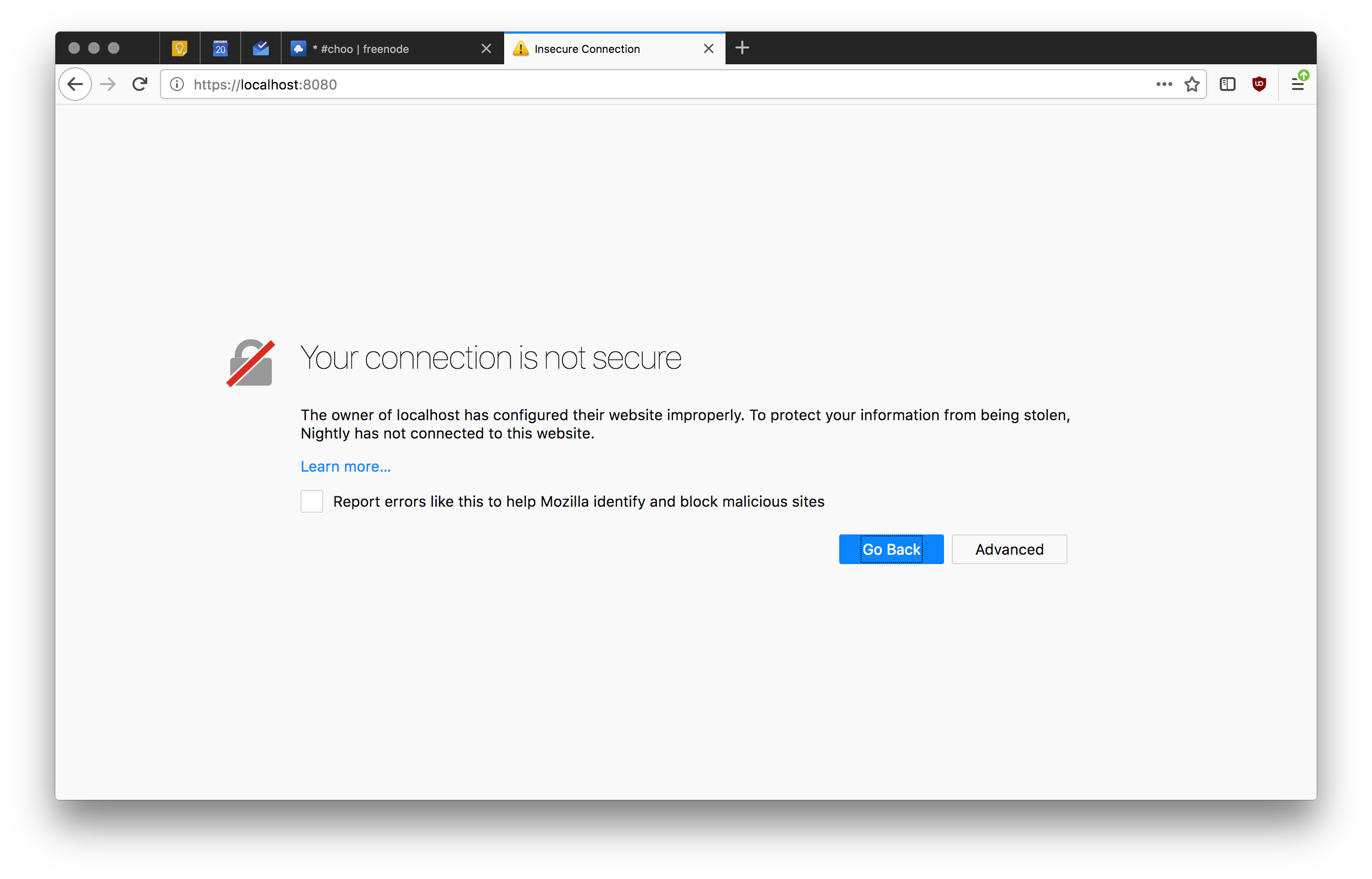
Step 2
More details emerge! Click on "Add Exception".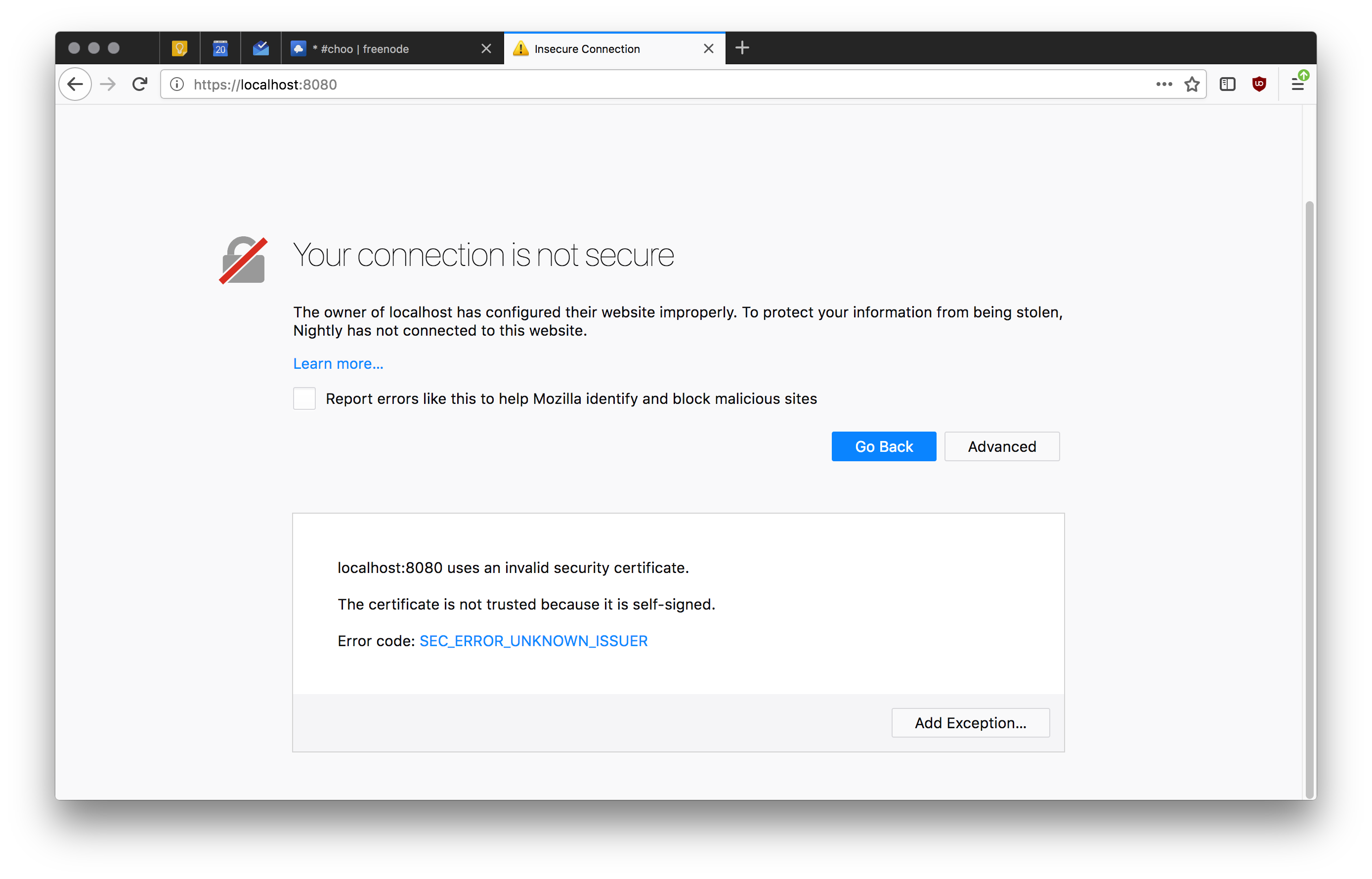
Step 3
In the dropdown click "Confirm Security Exception".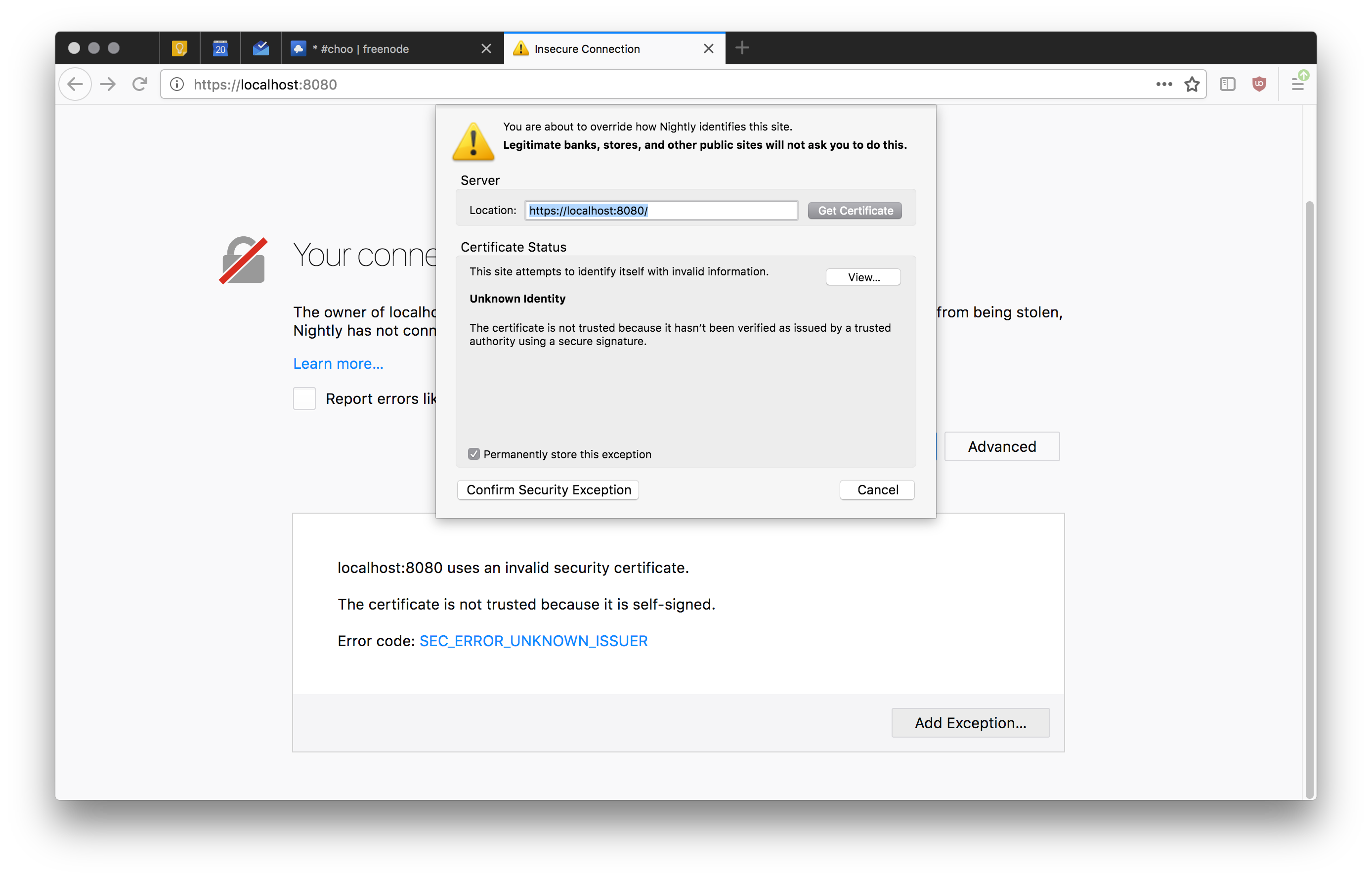
Step 4
Success!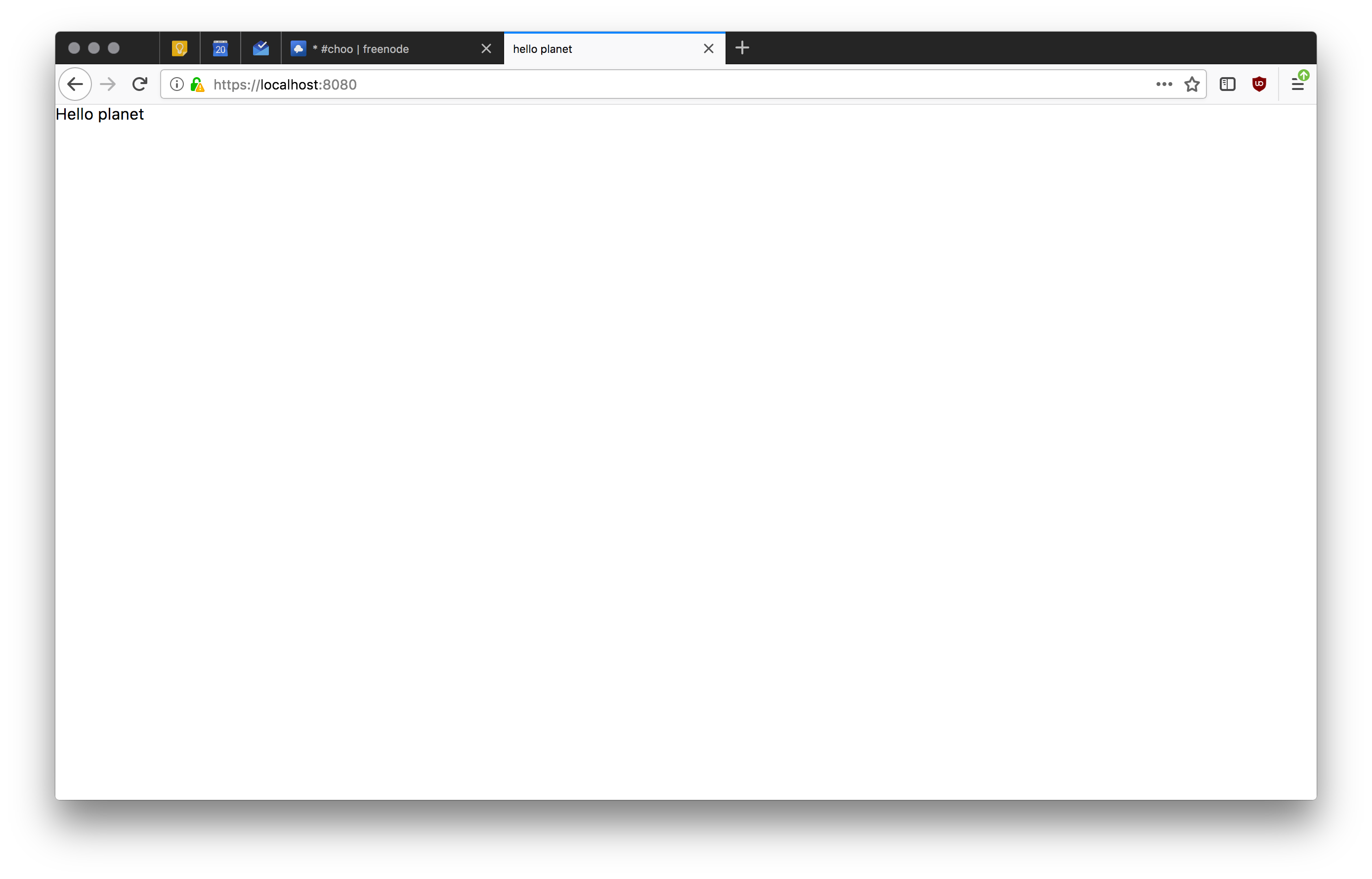
Chrome Instructions
Click the "more details" dropdown, then click "proceed". Pull Request for screenshots welcome!Safari Instructions
Step 1
A wild security screen appears! Click "Show Certificate".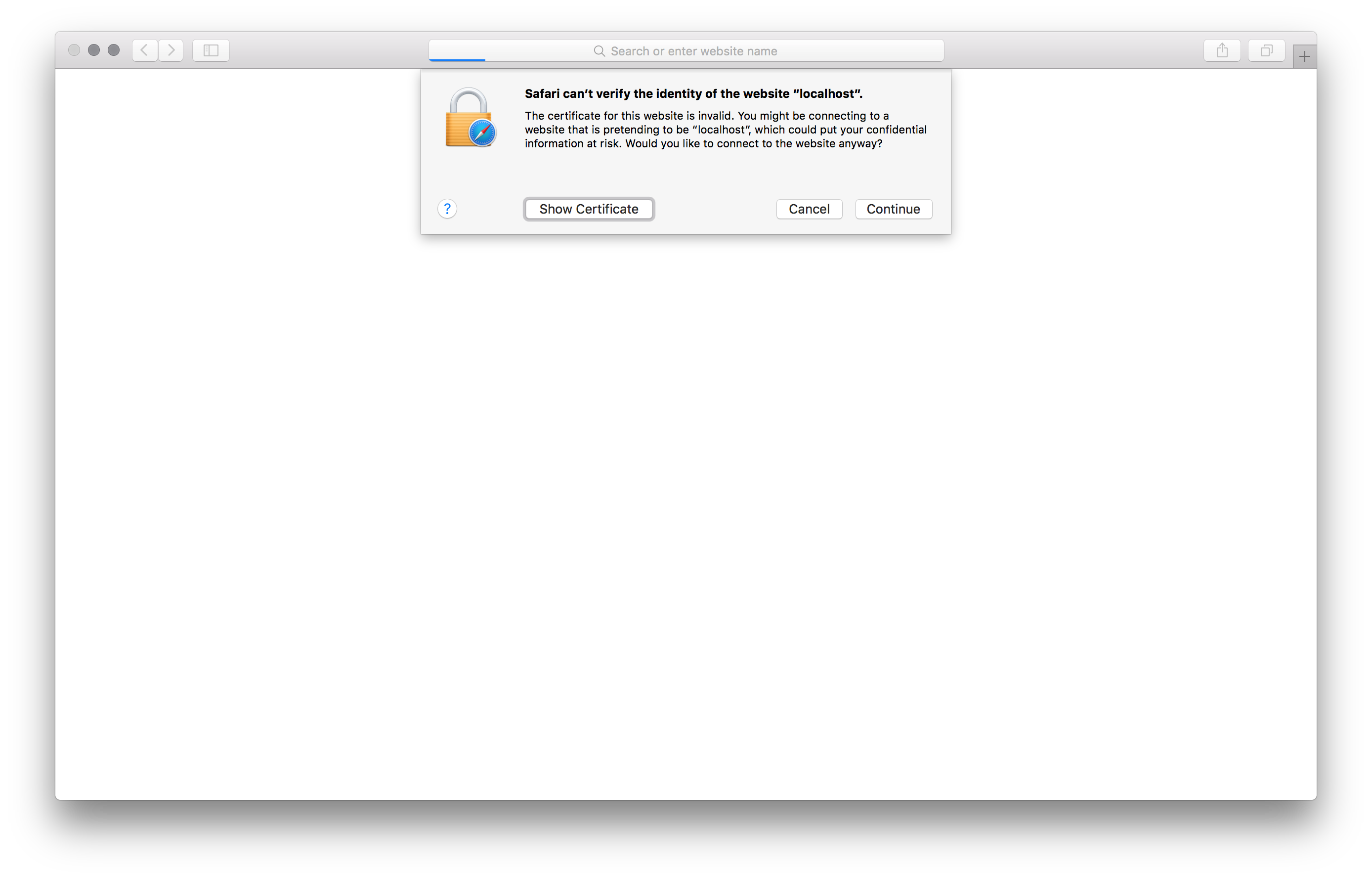
Step 2
More details emerge! Check "Always trust 'localhost'…".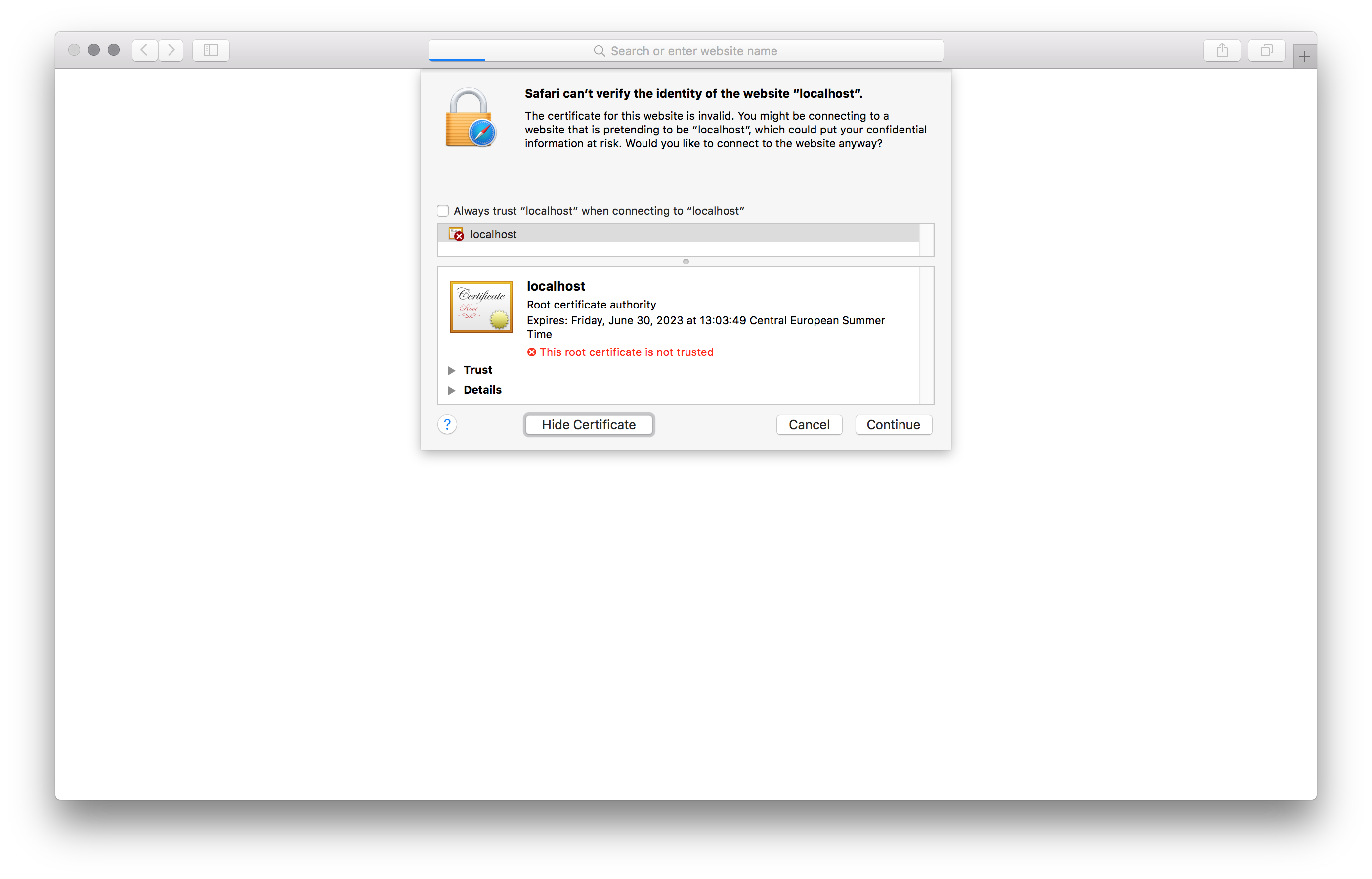
Step 3
The box is checked! Click "Continue".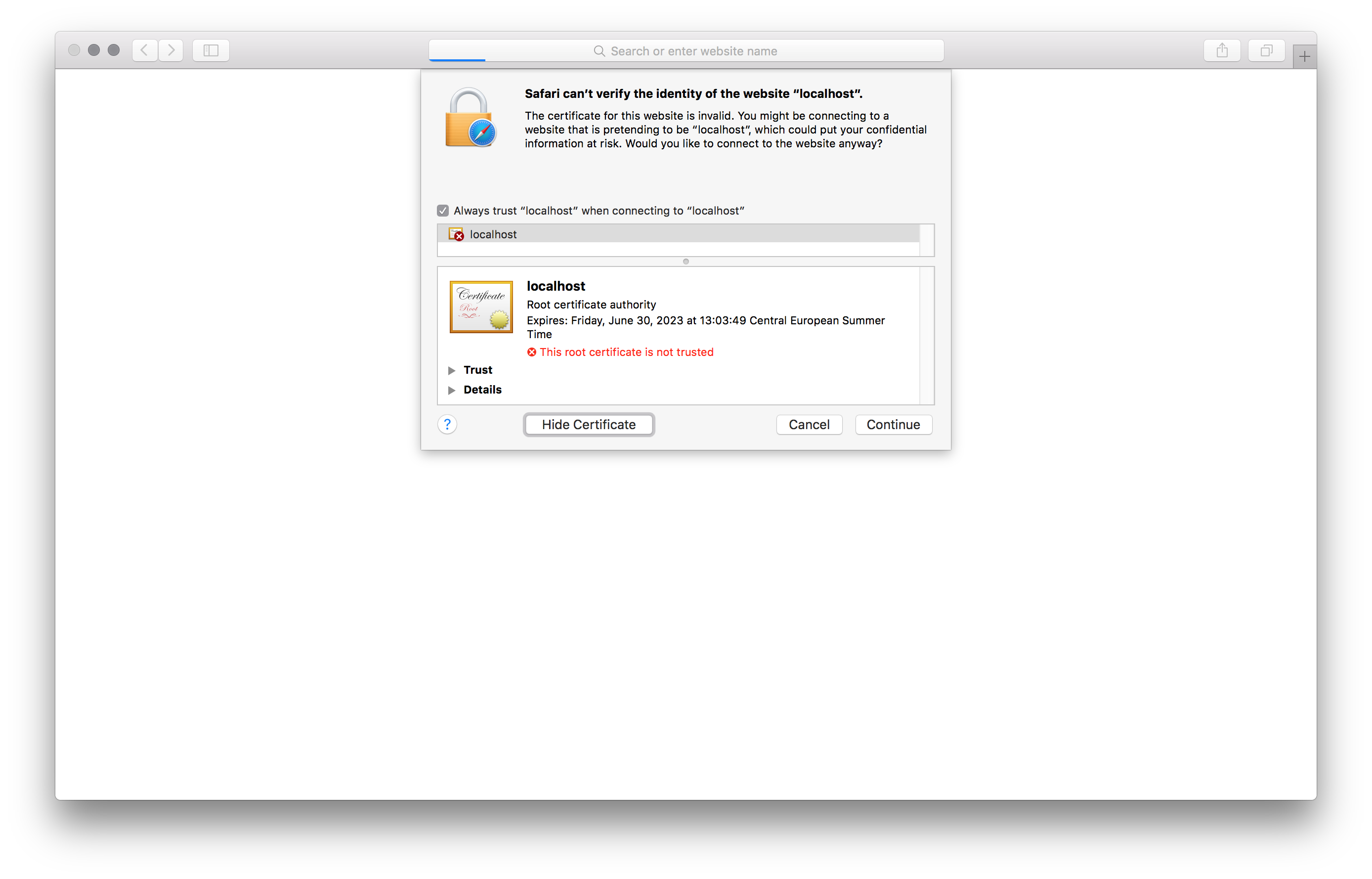
Step 4
A box is asking you for your crendentials. Fill them in, and hit "Enter".Step 5
Success!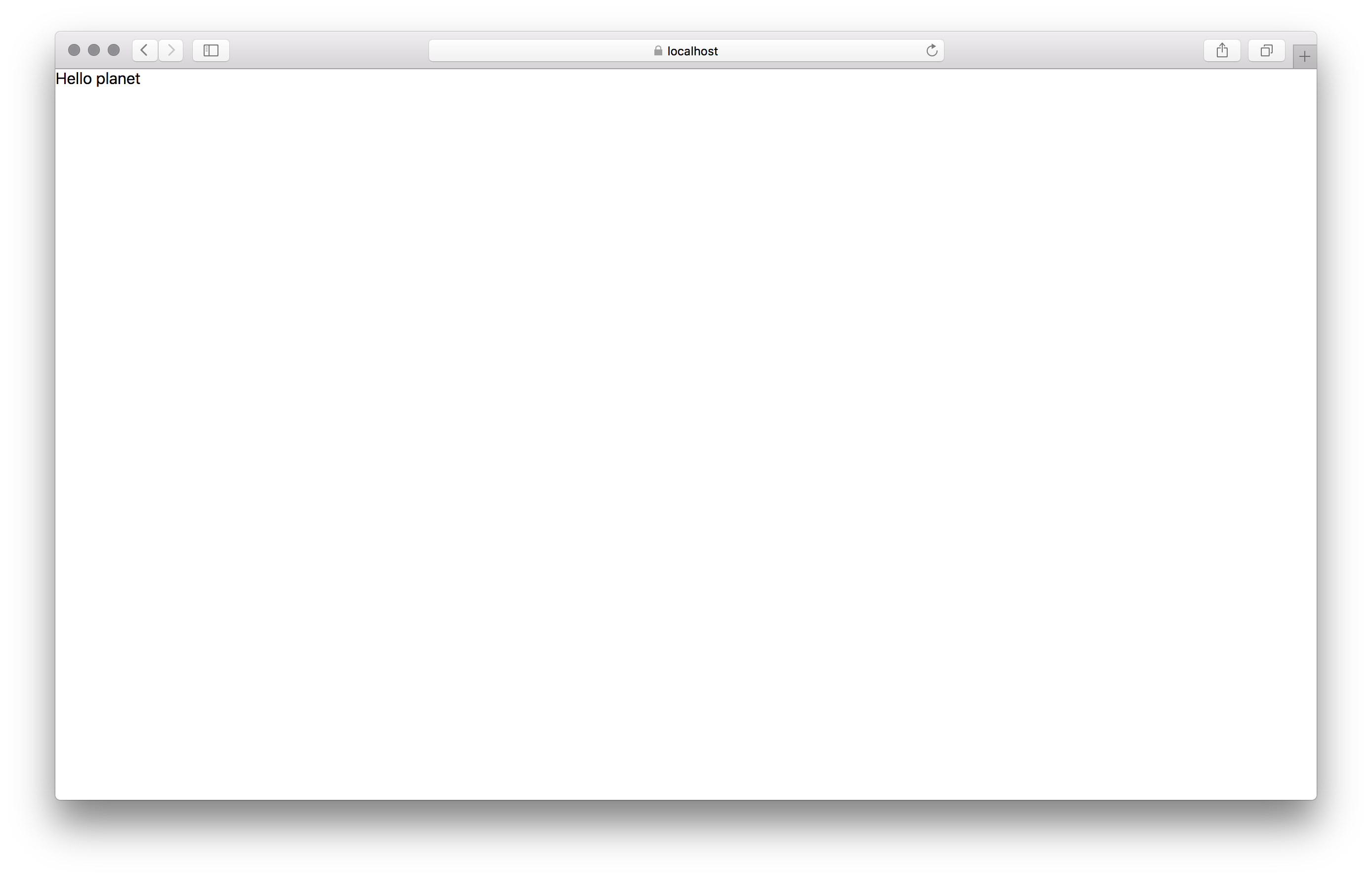
Optimizations
Bankai applies lots of optimizations to projects. Generally you won't need to care how we do this: it's lots of glue code, and not necessarily pretty. But it can be useful to know which optimizations we apply. This is a list:
JavaScript
-
nanohtml: Optimize
chooHTML code so it runs significantly faster in the browser. - glslify: Adds a module system to GLSL shaders.
-
brfs: Statically inline calls to
fs.readFile(). Useful to ship assets in the browser. - envify: Allow environment variables to be used in the bundle. Especially useful in combination with minification, which removes unused code paths.
-
split-require: Lazy load parts of your application using the
require('split-require')function. - babelify: Bring the latest browser features to all browsers. See our babel section for more details.
And bankai uses tinyify, which adds the following optimizations:
- browser-pack-flat: Remove function wrappers from the bundle, making the result faster to run and easier to minify.
- bundle-collapser: Remove all pathnames from inside the bundle, and replace them with IDs. This not only makes bundles smaller, it prevents details from your local dev setup leaking.
- common-shakeify: Remove unused JavaScript code from the bundle. Best known as dead code elimination or tree shaking.
-
unassertify: Remove all
require('assert')statements from the code. Only applied for production builds. - uglifyify: Minify the bundle.
CSS
-
sheetify: extract all inline CSS from JavaScript, and include it in
bundle.js. - purifyCSS: removes unused CSS from the project.
- cleanCSS: minify the bundle.
HTML
-
inline-critical-css: extract all crititical CSS for a page into the
<head>of the document. This means that every page will be able to render after the first roundtrip, which makes for super snappy pages. -
async load scripts: loads scripts in the background using the
deferattribute. -
async load styles: loads styles in the background using the
preloadattribute. -
async load styles: preloads fonts in the background using the
preloadattribute. - server render: server renders Choo applications. We're welcome to supporting other frameworks too. PRs welcome!
-
manifest: includes a link to
manifest.jsonso the application can be installed on mobile. - viewport: defines the right viewport dimensions to make applications accessible for everyone.
-
theme color: sets the theme color defined in
manifest.jsonso the navigator bar on mobile is styled on brand. -
title: sets the right title on a page. Either extracts it from the
application (choo only, for now) or uses whatever the title is in
manifest.json. - live reload: during development, we inject a live reload script.
Configuration
The Bankai CLI doesn't take any flags, other than to manipulate how we log to
the console. Configuring Bankai is done by modifying package.json.
Bankai is built on three technologies: browserify,
sheetify, and documentify. Because these can be
configured inside package.json it means that Bankai itself can be configured
from there too. Also if people ever decide to switch from the command line to
JavaScript, no extra configuration is needed.
{
"name": "my-app",
"browserify": {
"transform": [
"some-browserify-transform"
]
},
"sheetify": {
"transform": [
"some-sheetify-transform"
]
},
"documentify": {
"transform": [
"some-documentify-transform"
]
}
}Custom HTML
By default, Bankai starts with an empty HTML document, injecting the tags
mentioned above. You can also create a custom template as index.html,
and Bankai will inject tags into it instead.
If you export your Choo app instance after doing .mount(), Bankai respects the
mount location during server side rendering:
// app.js
...
module.exports = app.mount('#app')<!-- index.html -->
...
<body>
<div id="app"></div>
<div id="footer">© 2018</div>
</body>
...Service Workers
Bankai comes with support for service workers. You can place a service worker
entry point in a file called sw.js or service-worker.js. Bankai will output
a browserify bundle by the same name.
You can easily register service workers using choo-service-worker:
app.use(require('choo-service-worker')())choo-service-worker defaults to /sw.js for the service worker file name. If
you named your service worker service-worker.js instead, do:
app.use(require('choo-service-worker')('/service-worker.js'))Service workers have access to some environment variables:
- process.env.STYLE_LIST: An array of URLs to stylesheet files.
- process.env.SCRIPT_LIST: An array of URLs to script files.
- process.env.ASSET_LIST: An array of URLs to assets.
- process.env.DOCUMENT_LIST: An array of URLs to server-rendered routes.
- process.env.MANIFEST_LIST: An array containing the URL to the manifest file.
- process.env.FILE_LIST: An array of URLs to assets and routes. This can be used to add all your app's files to a service worker cache.
HTTP
Bankai can be hooked up directly to an HTTP server, which is useful when working on full stack code.
var bankai = require('bankai/http')
var http = require('http')
var path = require('path')
var compiler = bankai(path.join(__dirname, 'client.js'))
var server = http.createServer(function (req, res) {
compiler(req, res, function () {
res.statusCode = 404
res.end('not found')
})
})
server.listen(8080, function () {
console.log('listening on port 8080')
})Babel
Not all browsers support all of the Web Platform's features. So in order to use newer features on older browsers, we have to find a solution. The best solution out there at the moment is Babel.
Babel is a plugin-based JavaScript compiler. It takes
JavaScript in, and outputs JavaScript based for the platforms you've decided to
target. In Bankai we target the last 2 versions of FireFox, Chrome and Edge,
and every other browser that's used by more than 1% of people on earth. This
includes IE11. And if you have different opinions on which browsers to use,
Bankai respects .babelrc and .browserslistrc files.
Some newer JavaScript features require loading an extra library; async/await
being the clearest example. To enable such features, the babel-polyfill
library needs to be included in your application's root (e.g. index.js).
require('babel-polyfill')We don't include this file by default in Bankai, because it has a significant
size overhead. Once Babel includes only the language features you're using,
we'll work to include babel-polyfill by default.
Events
compiler.on('error', callback(nodeName, edgeName, error))
Whenever an internal error occurs.
compiler.on('change', callback(nodeName, edgeName, state))
Whenever a change in the internal graph occurs.
API
compiler = bankai(entry, [opts])
Create a new bankai instance. Takes a path to a JavaScript file as the first argument. The following options are available:
-
opts.quiet: Defaults to
false. Don't output any data tostdout. Useful if you have your own logging system. -
opts.watch: Defaults to
true. Watch for changes in the source files and rebuild. Set tofalseto get optimized bundles. - babelifyDeps: Defaults to true. Transform dependencies with babelify.
compiler.documents(routename, [opts], done(err, { buffer, hash }))
Output an HTML bundle for a route. Routes are determined based on the project's
router. Pass '/' to get the default route.
-
opts.state: Will be passed the render function for the route, and inlined
in the
<head>of the body aswindow.initialState.
compiler.scripts(filename, done(err, { buffer, hash }))
Pass in a filename and output a JS bundle.
compiler.assets(assetName, done(err, { buffer, hash }))
Output any other file besides JS, CSS or HTML.
compiler.styles(name, done(err, { buffer, hash }))
Output a CSS bundle.
compiler.manifest(done(err, { buffer, hash }))
Output a manifest.json.
compiler.serviceWorker(done(err, { buffer, hash }))
Output a service worker.
compiler.close()
Close all file watchers.
License
Apache License 2.0



